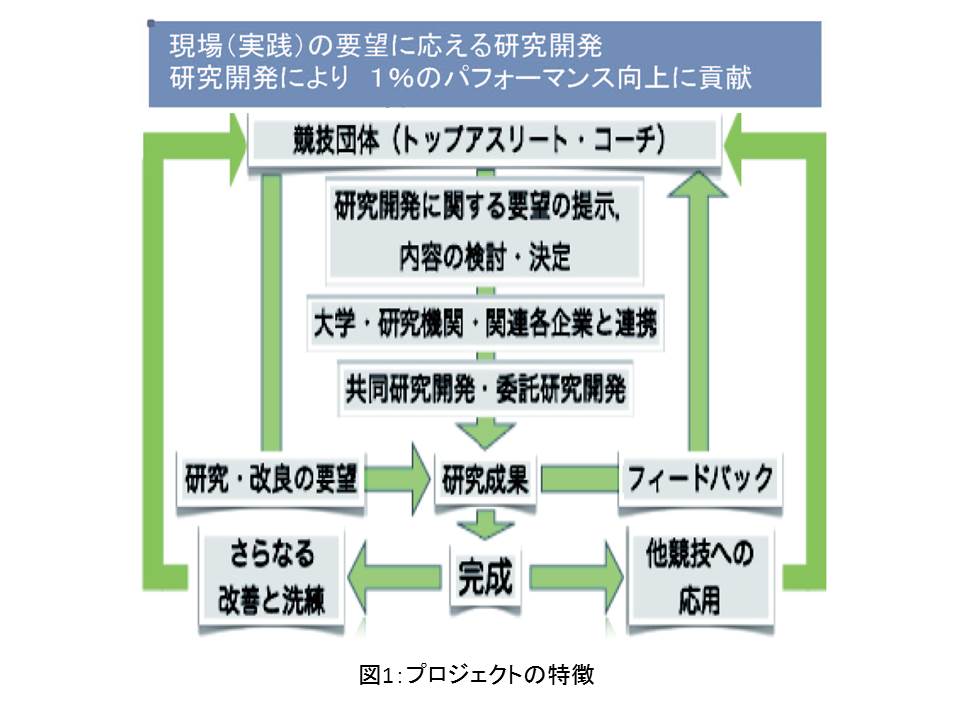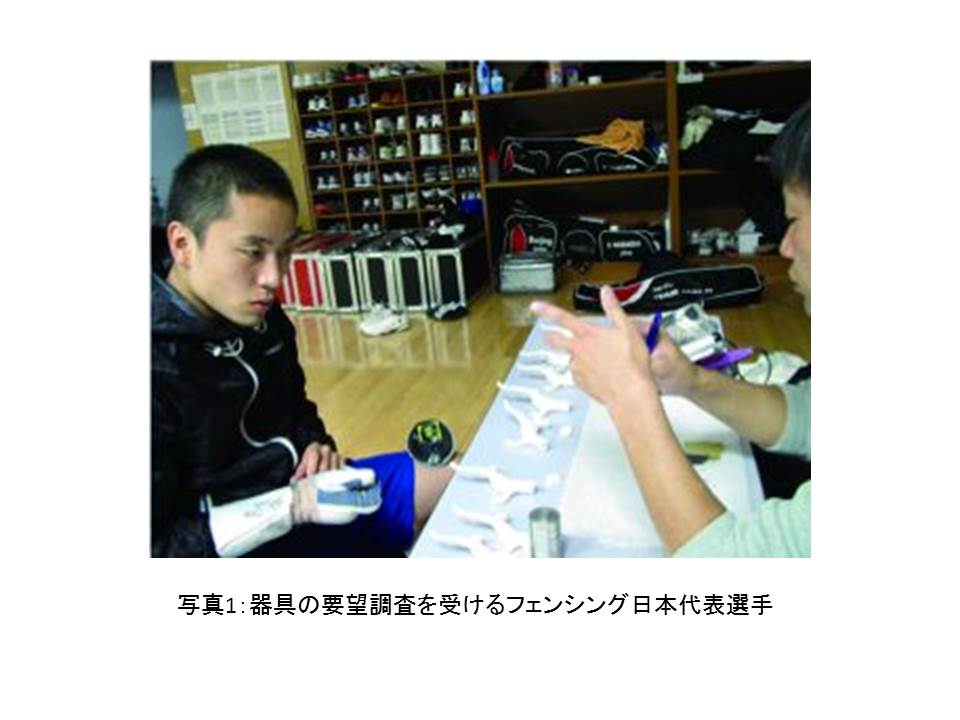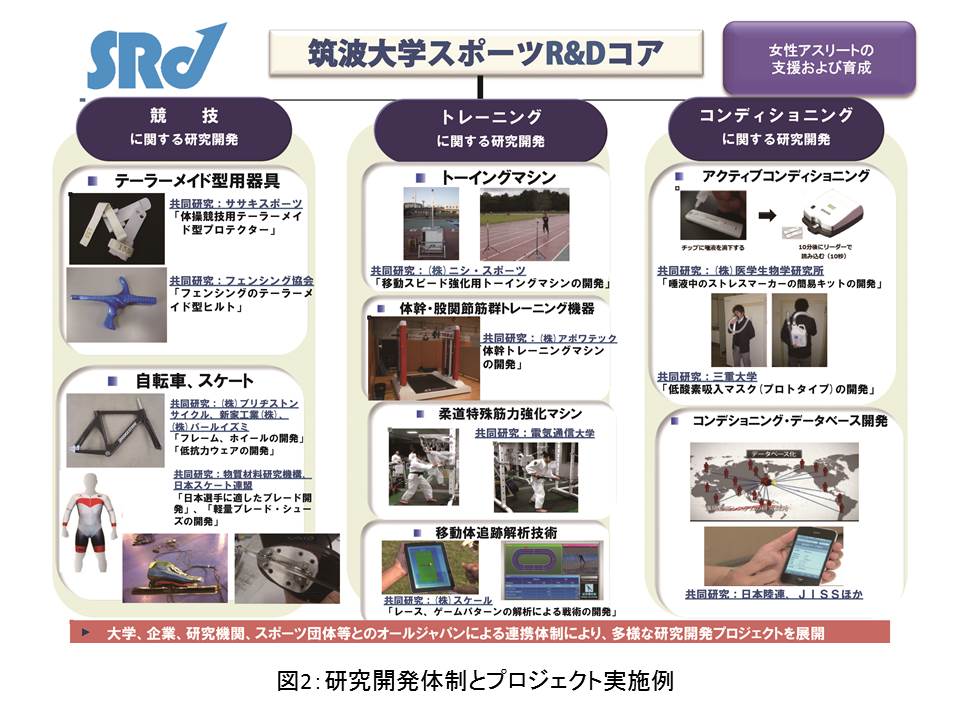キーワード:スポーツ、体育、健康、研究開発
 みなさん知っていますか?オリンピックでは0.01秒や1ミリで勝ち負けが 決まります。そして、選手が使う器具によってこの差が出てくる可能性があることが分かっています。その差を追求し、日本代表選手が少しでも良い成績を収 め、メダルを多く取ることと、その研究開発から得た技術を一般の人達の健康や体力、さらにはアジア・世界に還元しようとするリサーチユニットがあります。 それが「スポーツパフォーマンス研究開発」です(図1)。
みなさん知っていますか?オリンピックでは0.01秒や1ミリで勝ち負けが 決まります。そして、選手が使う器具によってこの差が出てくる可能性があることが分かっています。その差を追求し、日本代表選手が少しでも良い成績を収 め、メダルを多く取ることと、その研究開発から得た技術を一般の人達の健康や体力、さらにはアジア・世界に還元しようとするリサーチユニットがあります。 それが「スポーツパフォーマンス研究開発」です(図1)。

競技に関する研究開発
我々は競技に関する研究開発を守備範囲とし、それを基にトレーニング法やコンディショニング法に関する研究開発へつなげようとしています。選手達は少しで も良い結果を出すために日々厳しいトレーニングをしており、我々は選手の能力が引き出せる用器具の研究をしています(写真1)。例えば、フェンシングのグ リップ開発、移動スピードトレーニング機器の研究開発や体幹・股関節群トレーニング機器の研究開発などです(図2)。

オリンピック選手だけでなく一般の人も使える
みなさんも朝起きたら、体がだるいとか今日は調子がいいなと体の調子を感じると思います。体の調子がいい時に競技や大会に出場すると良い記録が出やすいも のです。このリサーチユニットにて開発した、体の調子を記録しデータベース化して分析する技術等を、オリンピック選手が使用し競技に生かすだけでなく、一 般の人が怪我なくスポーツをするために活用できる用器具や日々の運動方法・体調管理などに落としていきます(図2)。スポーツパフォーマンスと言いながら ヒューマンパフォーマンスの研究でもあるのです。

社会への貢献・実績
●22のプロジェクトで開発した用器具、トレーニング装置をロンドンオリンピック大会代表選手が実際の競技やトレーニングで使用
●2012年9月19日、研究開発プロジェクト活動概要および経過報告 記者発表会、筑波大学東京キャンパス
●2012年10月20日、シンポジウム「日本はなぜ女子スポーツ大国になったのか?」、国立スポーツ科学センター
●2013年3月28日、成果報告カンファレンス「オリンピックにおける研究開発の最先端」、筑波大学総合研究棟D
(取材:平成25年5月16日)
From Tsukuba to the World
Unit members : Okada, Hirotaka Kawai, Toshinobu Miyakawa, Shumpei Furukawa, Takuo Mukai, Naoki Takagi, Hideki Koike, Sekiya
Key words:sport science, physical education, health, research and development
In the Olympic and Paralympic Games, 0.01 seconds or 1 millimeter makes the difference between victory and defeat. Now we know that such a difference may also be due to equipment used by athletes. This research unit, Sport Performance Research and Development, focuses on this point, aiming to help  Japanese athletes improve their performance and obtain medals in competitions, while using the technologies resulting from research activities to improve general people’s health and human performance, as well as contributing to Asian and other countries (Figure 1).
Japanese athletes improve their performance and obtain medals in competitions, while using the technologies resulting from research activities to improve general people’s health and human performance, as well as contributing to Asian and other countries (Figure 1).

Figure 1: Characteristics of Our Research Projects
Sport Performance: Research and Development
Using the outcomes of studies on sport performance, we aim to provide a basis for the development of and research on training and conditioning methods. To support athletes engaged in intensive training daily to improve their performance, we examine optimal equipment for them to harness their ability to the fullest (photograph 1). For example, up to the present, we have studied and developed fencing grips and training devices to increase the speed of movement or strengthen the trunk and hip joint muscles (Figure 2).

Photograph 1: A Japanese representative fencing athlete undergoing an equipment needs assessment survey.
Technologies for All People
When we wake up in the morning, we perceive our daily physical condition, such as “I feel tired ” or “I am in good shape today”. Favorable physical conditions frequently lead to favorable competition results. Therefore, in this research unit, techniques to record physical conditions and create databases have been developed and applied to equipment and devices, daily exercise methods, and health maintenance approaches not only for Olympic athletes to improve their performance, but also for general people to safely enjoy sports (Figure 2). In this respect, our focus is not limited to sport performance, but also covers human performance.

Figure 2: R&D Project Implementation Systems and Examples
Social contributions and achievements
●Offering the equipment and devices developed through 22 research projects to Japanese athletes at the London Olympics 2012 for competitions and training
●Holding a press conference and reporting the outlines and progress of R&D projects on September 19, 2012 at the Tokyo Campus, University of Tsukuba
●Holding a conference entitled: How Has Japan Become a Women’s Sporting Power, on October 20, 2012 at the Japan Institute of Sports Sciences
●Holding a conference entitled: Latest Trends in Olympic-related R&D, to report the progress of research activities on March 28, 2013 in General Research Building D, University of Tsukuba
